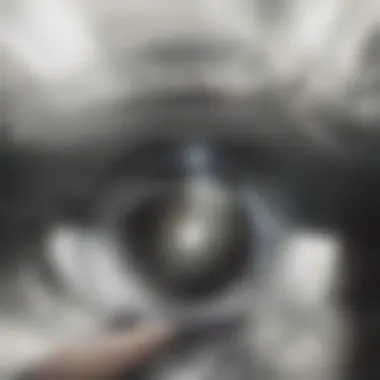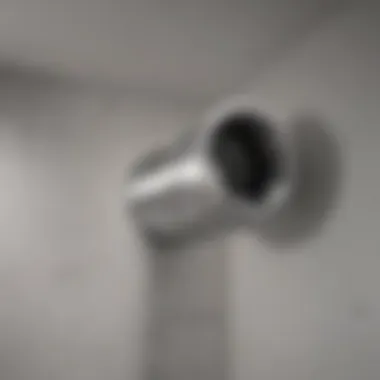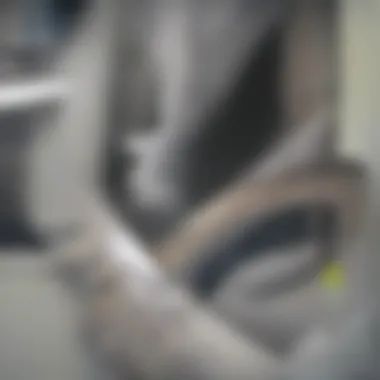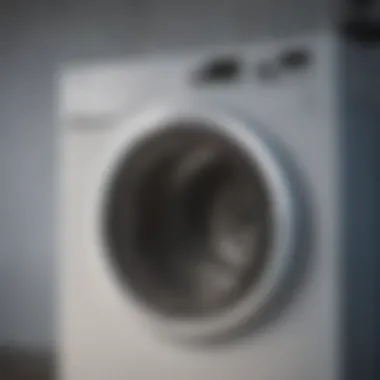Attaching Dryer Ducts: A Comprehensive Guide


Intro
Attaching a dryer duct is an often neglected aspect of home maintenance that can severely affect the efficiency of your dryer and the safety of your home. This guide will provide a detailed look into the entire process, from selecting the correct tools and materials to understanding key safety measures.
Proper installation not only ensures that laundry cycles are efficient but also minimizes the risk of lint buildup, which poses a fire hazard. This guide is tailored for homeowners and DIY enthusiasts who wish to familiarize themselves with best practices in dryer duct installation.
Key Points
- Importance of proper duct attachment for efficiency and safety.
- Tools and materials necessary for effective installation.
- Step-by-step instructions for attaching dryer ducts.
- Maintenance tips to ensure long-lasting performance.
"Properly installed dryer ducts are critical to maintaining airflow and reducing the risk of fire hazards."
As we delve deeper into each aspect, the objective is to provide a rich understanding of the nuances involved in this seemingly simple task.
Featured Tools and Materials
Before beginning, it’s essential to gather all necessary tools and materials. The following list outlines what you will need for a successful installation:
- Dryer ducting material (rigid or flexible)
- Duct tape or metal clamps
- Sheet metal screws
- Drill
- Screwdriver
- Measuring tape
- Utility knife
- Safety goggles
Each tool and material has a specific role in the installation, ensuring that everything fits together securely and functions optimally.
Safety Considerations
Before commencing any installation, safety should be your first concern. Always wear safety goggles to protect your eyes from debris. Follow these basic safety guidelines:
- Ensure the dryer is unplugged.
- Avoid installing ducts in areas with high moisture.
- Regularly clear lint build-up from ducts during maintenance.
By focusing on the necessary steps and precautions, anyone can become proficient in the art of dryer duct attachment, thus enhancing the efficiency of their appliances.
Understanding Dryer Ducts
Understanding dryer ducts is crucial for effective home management and ensuring the lifespan of your appliances. A well-installed dryer duct optimizes efficiency and enhances safety within the home. Proper airflow reduces drying times, which can lead to energy conservation. Moreover, a correctly attached duct minimizes risks associated with lint accumulation, which poses a fire hazard.
What is a Dryer Duct?
A dryer duct is a crucial component in connecting the dryer to the external vent. This duct channels hot, moist air from the dryer outside, preventing excessive humidity that could damage the home and the appliance itself. Typically made from metal or flexible plastic, dryer ducts vary in length and diameter. Selecting the right type and size is pivotal for optimal performance. The main purpose is straightforward:.
- To allow moisture and heat to exit the home after drying clothes.
- To ensure efficient airflow that minimizes the dryer’s workload.
Key Characteristics of Dryer Ducts:
- Material Composition: Ducts can be crafted from rigid aluminum, galvanized steel, or flexible vinyl.
- Diameter Sizing: Common diameters include 4 inches for residential dryers.
The Importance of Proper Attachment
Proper attachment of dryer ducts is non-negotiable for two primary reasons: efficiency and safety. If a duct is not securely fixed, it can disconnect, creating hazardous situations. Gaps allow lint to escape, increasing the risk of fire. Additionally, leaks can result in diminished airflow, causing the dryer to operate harder and thus potentially shortening its lifespan.
"A securely connected dryer duct not only optimizes the appliance's efficiency but is pivotal in safeguarding your home against fire risks."
Benefits of Proper Attachment:


- Improved Efficiency: Ensures that the dryer can operate effectively, reducing energy bills.
- Enhanced Safety: Significantly lowers the chances of lint buildup, a common fire hazard.
- Extended Appliance Life: Regularly maintained and connected ducts prolong the life of the dryer.
Required Tools and Materials
The section on Required Tools and Materials serves as a key foundation for understanding how to successfully attach a dryer duct. Equipped with the right tools and materials, homeowners can ensure a safer and more efficient installation process. Failing to use proper tools can lead to poor duct connections, exacerbating safety concerns such as fire hazards due to lint buildup or ineffective ventilation. Therefore, being knowledgeable about these elements is critical.
Essential Tools
To perform a competent installation of dryer ducts, certain tools are indispensable. These essential tools not only facilitate the process but also ensure that the task is executed efficiently and correctly.
- Screwdriver: A screwdriver is often necessary for securing duct sections and fasteners. Depending on your duct type, you may need a flathead or Phillips screwdriver.
- Tin Snips: These are useful for cutting metal ducting. Having a precise cutting tool prevents jagged edges that can cause damage to other components.
- Duct Tape: This is not ordinary tape but specialized. It must be a UL-listed foil tape for durability and longevity in holding duct seams together.
- Level: For proper alignment, a level is crucial. It ensures that ducts are installed without unnecessary bends or sagging, promoting better airflow.
- Measuring Tape: Accurate measurements are vital for cutting ducts to the correct lengths. A measuring tape allows for quick and precise distance measurements.
Material Types for Dryer Ducts
Choosing the right materials for dryer ducts is as important as the tools used. This selection significantly impacts not only the efficiency of your dryer but also the overall safety of your home. Different duct materials come with unique benefits and constraints:
- Flexible Ducting: Generally made from plastic or aluminum, this type is easy to install and maneuver around corners. However, it can accumulate lint more easily.
- Rigid Aluminum Ducting: This is recommended for dryer exhaust because it does not sag easily and reduces airflow resistance. It is long-lasting but requires precise installation.
- Foil Ducting: This type is lightweight and easy to handle but can be prone to damage if not installed correctly.
- PVC Ducting: Though less common, this material is resistant to corrosion and can handle high temperatures. However, it might not pass certain building codes, hence verification is necessary.
When selecting duct materials, always consider local building codes. Compliance is essential not just for legality but also for safety and performance. Additionally, evaluating ventilation needs alongside materials helps ensure that your dryer will operate efficiently and safely over its lifespan.
Safety Considerations
Safety is paramount when working with dryer ducts. Attaching dryer ducts may seem straightforward, but neglecting safety precautions can lead to severe consequences, from property damage to personal injury. This section discusses the significance of maintaining safety standards, detailing the equipment you need and fire safety protocols to be followed during the installation process.
Personal Protective Equipment
When attaching a dryer duct, personal protective equipment (PPE) is crucial. PPE serves as the first line of defense against potential hazards associated with the task.
- Gloves: Durable gloves protect your hands from sharp edges when handling metal ducts. This prevents cuts and scrapes.
- Safety Goggles: Eye protection is essential, especially when cutting or fitting duct materials. Flying debris can cause serious eye injuries.
- Dust Masks: A dust mask helps filter out fine particles created during cutting. This is particularly important in poorly ventilated areas to avoid respiratory issues.
- Hearing Protection: Using power tools can generate significant noise. Earplugs or earmuffs protect your hearing, especially when working for extended periods.
Using PPE not only provides physical protection but also instills a sense of responsibility towards health and safety protocols.
Fire Safety Protocols
Fire safety protocols must be a priority when attaching dryer ducts. This stems from the fact that improperly installed or maintained ducts can be a significant fire hazard. Here are key fire safety considerations:
- Material Selection: Always choose materials that are rated for high temperatures and are resistant to catching fire. Aluminum and galvanized steel are ideal. Avoid plastic ducts in any part of the venting system.
- Clearances: Ensure that the ductwork is not in contact with flammable materials. Maintain the minimum clearances specified by local building codes to prevent heat buildup.
- Regular Inspections: After installation, regularly check the duct for blockages and lint buildup, which is a leading cause of dryer fires. These inspections can reduce the risk significantly.
“A thorough understanding of fire safety protocols is essential for preventing dryer duct-related hazards.”
- Installation Practices: Follow the manufacturer's guidelines for installation. Ensure all connections are secured properly to prevent disconnections, which could allow hot air to escape.
By adhering to these guidelines, homeowners can significantly mitigate risks associated with dryer duct attachment. These precautions create a safer environment for everyone involved, ensuring the longevity of the dryer system while upholding safety standards.
Step-by-Step Guide to Attaching the Dryer Duct
Attaching a dryer duct might seem straightforward at first glance, yet the details involved are crucial for ensuring efficiency and safety in your home. A well-connected duct not only optimizes the dryer’s performance but also reduces the risk of fire hazards. Each step in this process contributes to proper ventilation. It is important to pay attention to the installation area, correct measurements, and secure attachments.
Preparing the Installation Area
Before starting the installation, preparation is key. First, ensure the installation area is free from clutter and debris. Remove any obstacles that could hinder the installation process. In general, clean the surrounding space to allow full access to the wall where the duct will connect.


Next, assess the location of any existing electrical outlets or other appliances nearby. This avoids unnecessary complications during the installation. It might be useful to mark the area where the dryer will be positioned. Use a tape measure to confirm that the dryer fits comfortably, allowing some space for the duct itself. Proper preparation sets the stage for a smoother installation.
Measuring the Duct Length
Accurate measurement is very important in this process. First, take the measurement from the dryer’s exhaust vent to the wall vent. This usually involves a straight path. Use a tape measure to gauge this distance carefully. It is essential to remember that flexibility in ducting requires allowances for bends and turns.
If your path includes one or more elbows, measure the amount of duct that will be needed to make those connections. It is advisable to cut the duct slightly longer than the measurements suggest, as this provides a buffer during the actual attachment. Get it right at this stage to ensure a snug fit when you finalize the installation.
Attaching the Duct to the Wall
With the duct cut to the required length, it is time to attach it to the wall vent. Begin by aligning the duct properly. Slide one end of the duct onto the wall vent opening. Use a level to ensure it is straight. This step is critical as misalignment can lead to inefficiencies or blockages in airflow.
After aligning, use clamps or screws to secure the duct firmly in place. If using metallic duct tape, wrap it around the connection tightly to further ensure a proper seal. This arrangement can help prevent any air leakage, which in turn preserves dryer efficiency.
Securing the Duct Connections
Securing the duct connections is the final crucial step in this process. After attaching the duct to both the dryer and the wall vent, check all connections carefully. It is important that each joint is tightly sealed. Loose connections can lead to air leaks, which may cause moisture build-up and increase the risk of mold in your home.
To secure connections, use duct tape appropriately threaded through the joint sections. Alternatively, clamps can be employed for a more durable fix. It is advisable to double-check each connection once more to ensure that everything is properly secured. If all connections are tight, then proceed to check the overall installation for any noticeable gaps or loose areas.
Proper installation of a dryer duct is essential for efficient operation and safety. A few minutes spent on meticulous attachment can save significant energy costs and prevent hazards.
In summary, each step in attaching the dryer duct plays a significant role in the overall efficiency and safety of the dryer. From preparing the area to securing the duct connections, the process requires attention to detail and precision. Following these detailed instructions lays a foundation for optimal dryer performance.
Ventilation Requirements
When attaching dryer ducts, understanding ventilation requirements is crucial. This step is often overlooked, yet it has significant implications for both the efficiency of the dryer and the safety of the home. Proper ventilation prevents the buildup of lint and moisture, which can lead to serious problems such as mold growth and house fires. Moreover, efficient airflow enhances the drying process, reducing energy consumption.
Understanding Ventilation Needs
Ventilation is about ensuring that the moist air produced by the dryer is effectively exhausted outside. Without sufficient ventilation, this air can recirculate back into the laundry area or even into other parts of the home, creating a damp environment. The American National Standards Institute (ANSI) suggests that dryer ducts should be a minimum of four inches in diameter to facilitate optimal airflow. Here are essential points to consider:
- Duct Size: Maintain a consistent duct size throughout the system to avoid bottlenecks. Larger diameter ducts promote better airflow.
- Duct Length: Keep the duct as short as possible. Longer ducts can reduce the efficiency of airflow. Consider planning the duct route carefully to lessen the distance.
- Duct Material: Use duct materials that allow for smooth airflow. Rigid metal ducts are generally recommended over plastic or flexible versions, as they resist lint buildup and do not warp.
All these aspects ensure that the dryer operates efficiently and safely, reducing wear and tear on the machine and minimizing the risk of fire hazards.
Compliance with Local Building Codes
Adhering to local building codes is not just a formality; it is a critical step that ensures both safety and efficiency. Most regions have specific codes regulating dryer duct installation, addressing materials, length, and routing. Failing to comply can lead to fines or legal issues should an inspection arise.
Key components of compliance include:
- Material Standards: Ensure that the selected duct material meets local fire safety standards. Many areas require non-combustible materials.
- Installation Guidelines: Follow local codes pertaining to how ducts must be secured, angled, and vented. These regulations often stipulate the maximum permissible duct length and maximum number of bends.
- Ventilation Openings: Local codes may also outline the proper size and placement of external vent openings, which helps prevent back drafts and blockages.
Being informed about and compliant with local building codes not only fosters safety but also promotes energy efficiency. Regularly consulting guidelines set by organizations like the International Residential Code (IRC) can be invaluable for homeowners and contractors alike.
Common Problems and Solutions
Understanding common problems related to dryer ducts is crucial for homeowners and DIY enthusiasts. This section emphasizes the importance of recognizing issues that can arise during the installation and maintenance of dryer ducts. Knowing how to identify and address these problems can enhance the efficiency of your dryer, reduce fire risks, and maintain optimal ventilation. Below are some prevalent issues faced in this context, along with practical solutions.
Leaks and Blockages


One of the most frequent problems encountered with dryer ducts is leaks. These can occur at joints where the duct connects to the wall or the dryer. Leaks reduce the efficiency of the dryer and can lead to increased drying times, which in turn elevates energy costs. Blockages, often caused by lint accumulation or debris, also pose significant challenges. They can lead to overheating and a higher risk of fire.
Solutions:
- Regularly inspect all connections to ensure they are tight and properly sealed. Consider using metal tape or clamps for added security.
- Clean the ducts at least once a year to prevent lint build-up. A vacuum cleaner with a hose attachment can be effective for this task.
- Install a lint trap in the ducting system to catch debris before it reaches the vent exit.
Duct Disconnection Issues
Duct disconnection can often happen due to improper installation or over time due to vibrations from the dryer during use. This may lead to inadequate drying, increased humidity levels in the laundry area, and could also contribute to lint buildup.
Solutions:
- Ensure that the duct is securely attached both at the dryer and at the wall connection. Using screws or metal tape can bolster the fastening.
- Regularly check the duct’s physical condition, especially after moving appliances or renovations.
- If disconnections are frequent, consider investing in a rigid duct system that is less prone to movement.
Noise and Vibration Troubles
Noise and vibrations emitted during dryer operation can indicate issues within the duct system. Excessive noise can stem from loose or unbalanced ducts. Vibrations may also worsen over time, leading to disconnections and even damage to your appliance.
Solutions:
- Assess the duct for any loose fittings. Tightening these connections can greatly reduce noise.
- Use vibration-absorbing pads under the dryer to minimize noise and movement.
- If noise persists despite these measures, consider replacing flexible ducts with rigid ones to prevent excessive movement.
Maintenance Tips for Dryer Ducts
Proper maintenance of dryer ducts is essential for ensuring efficient operation and safety in your home. Neglecting this aspect can lead to various issues, including reduced dryer performance, increased energy consumption, and, more critically, a heightened risk of fire. Regular maintenance helps to prolong the lifespan of your dryer and duct system.
Maintaining dryer ducts is not merely an option; it is a necessity. A well-maintained duct system can improve air flow, prevent lint build-up, and enhance the overall performance of your dryer. Furthermore, an annual check-up can also identify underlying problems before they escalate into costly repairs or hazardous situations.
Routine Cleaning Practices
Routine cleaning of dryer ducts involves several steps that homeowners should regularly perform. Here are a few practices to integrate into your maintenance routine:
- Disconnect and Clean: Before starting, always disconnect the dryer from its power source. This step is crucial for your safety. Next, detach the duct from the wall and the dryer for thorough cleaning.
- Use a Lint Brush: A lint brush is a valuable tool for cleaning the inside of the duct. Insert the brush into the duct and scrub to remove lint build-up. Ensure you cover both sides of the duct.
- Vacuuming: After brushing, use a vacuum to remove any loosened debris. Pay attention to corners and bends in the duct where lint often accumulates more.
- Inspect Regularly: At least once every six months, check the duct for blockages or signs of wear. Deformities or holes in the duct can lead to inefficiencies or increase fire risks.
By incorporating these habits into your maintenance routine, you can keep your dryer ducts functioning effectively and mitigate potential hazards.
Signs of Wear and Tear
Recognizing signs of wear and tear in your dryer ducts is vital for maintaining safety and efficiency. Homeowners should look for specific indicators:
- Decreased Efficiency: A sudden spike in drying times can signal a blockage or duct issue. If your clothes take longer than usual to dry, investigate the duct system.
- Unusual Odors: A burnt smell while using the dryer might indicate that the lint is accumulating excessively, possibly causing overheating.
- Disconnected Ducts: If you notice the duct sections separating, it could lead to air leaks and decreased efficiency. Make it a point to check for disconnections during your regular inspections.
- Physical Damage: Cracks or holes in the duct can negatively affect ventilation. Inspect your ducts for any visible cracks that may need immediate attention.
Being proactive in identifying these signs can save significant time and costly repairs down the road. Addressing these symptoms promptly ensures that your dryer ducts remain in good condition.
End
The conclusion of this guide serves as a significant wrap-up of the critical aspects involved in attaching dryer ducts. This section emphasizes the necessity of understanding each stage of the installation process. Proper attachment is essential not only for the functionality of the dryer but also for the safety of your home. A well-installed duct reduces the risk of fire, prevents moisture buildup, and enhances energy efficiency.
Recap of Key Steps
Here we summarize the vital steps that have been covered:
- Understanding the Dryer Duct: Recognizing its role and significance.
- Tools and Materials: Identifying what is necessary to perform the installation.
- Safety Considerations: Being aware of personal protective equipment and fire protocols.
- Step-by-Step Guide: Preparing the area, measuring, attaching, and securing the duct.
- Ventilation Requirements: Acknowledging the compliance aspects.
- Common Issues: Understanding potential problems with solutions.
- Maintenance Tips: Knowing how to keep the ducts clear and in good condition.
By following these steps, homeowners and DIY enthusiasts can ensure a successful installation that will function correctly over time.
Final Thoughts on Installation
Completing the installation of dryer ducts is not merely a task; it is a commitment to maintaining a safe and efficient home. Proper installation can lead to optimal performance of your dryer and reduce the risk of hazardous conditions. Careful consideration during installation—from selecting quality materials to ensuring proper ventilation—makes a significant difference. It is advisable to revisit your installation periodically to ensure everything remains secure and functional. For anyone interested in home improvement, mastering these steps provides both practical skills and peace of mind. Remember, a small investment of time and attention to detail today can result in significant benefits for the future.







